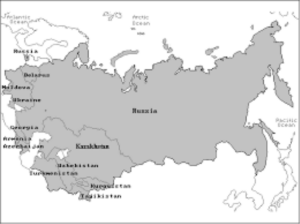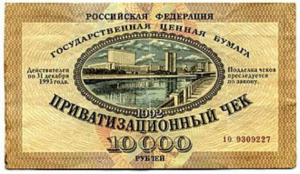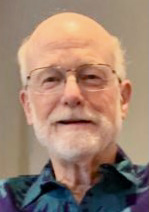by Desaix Myers
We were in the dark. Launching an aid program as the Soviet Union collapsed, covering 12 countries across 11 time zones from Kiev to Vladivostok, took the U.S. Agency for International Development (USAID) into totally new territory. Most of us had spent careers in the tropics. Almost no one in USAID knew anything about Russia or the former Soviet Union. No one spoke Russian.

In June 1992, I joined USAID’s recently formed New Independent States (NIS) Taskforce as Russia Desk Officer. My knowledge of Russia consisted of what I had learned from “Russian Lit in Translation” sophomore year and a one-week trip with the University of California to see about a possible partnership with the university in Puschino, a small town dedicated to microbiology 90 kilometers south of Moscow. Concerned that Puschino, formerly a closed city, might be a center for research on biological warfare, we went to the CIA for reassurance—they said it wasn’t.
Setting Up
In those early days of the USAID Taskforce, the CIA was our go-to agency for background on the region. With the collapse of the country they’d spent their lives studying, a couple of hundred talented analysts were in the market for new clients. USAID was a promising prospect. The agency offered up their A-team for lectures on the prospects for political change and economic reform. We asked about living in Moscow. The greatest personal danger, they said, would be slipping on the ice.
Initially, everything was run from Washington with technical teams in health and humanitarian assistance, economic growth, democracy, housing, and energy going to the field, assessing need, developing programs, and contracting for implementation. We soon realized that these programs needed coordination, management, and follow up on the ground — field missions with professional staff.
Setting up full missions was complicated. U.S. government agencies across Washington were fighting over scarce overseas slots and embassy services. State Department security officers were concerned about USAID’s need to recruit local employees in Russia and elsewhere. Logistics were complex. Housing was short. In Moscow, an intrepid entrepreneur had decided to import modular townhouses from Norwalk, Connecticut to create a new, Americanized suburb, Rossinka, outside of town; the embassy and USAID bought a number of them. They came with saunas and woods for cross-country skiing outside their doors; they were close to the international school, but they were also a long bus ride away from the Bolshoi, Red Square, and the history and mystery of Moscow.
Early Visits
Pervading the entire interagency involved in NIS programming was a real sense of urgency coming from concern for security and stability in the region and fears that the willingness to reform might be short-lived. The problems were vast, but so seemed the opportunities. There was much to learn, and the early lessons were fraught with history and at times bizarre, out-of-body juxtapositions. Senior leaders needed to see for themselves what was going on
When USAID’s chief operating officer, Scott Spangler, visited St. Petersburg in November 1992, he was nearly run over in Palace Square on his way to the Hermitage by black-clad Communists, marching through the snow, waving red banners, re-enacting 75 years to the day the Bolsheviks’ attack on Alexander Kerensky in the Winter Palace. Later that night he attended HBO’s world premiere of “Stalin,” screened in the Kremlin, with Robert Duvall and the real Stalin’s grandson at the reception.
In 1993, shortly after President Clinton’s inauguration, USAID Administrator Brian Atwood took off on military transport to get a first look at his assistance empire. I joined as bag carrier. My seatmate was Bill Taylor. Now famous from his time as ambassador to Ukraine, Bill was then working for Rich Armitage in the State Department’s Office of the Coordinator of U.S. Assistance to Europe and Eurasia. We started in Kiev at the statue of St. Vladimir, the founder of Kievan Rus and adopter of Christian Orthodoxy, claimed by both Ukraine and Russia; visited Babi Yar, where nearly 35,000 Ukrainian Jews died in two days of mass killings in 1941; and met then-prime minister and later president Leonid Kuchma. We scrambled to understand the historical and political context. A new Mission Director had just arrived; he was only beginning to assemble staff and there was no program to speak of.
In Russia, Atwood’s next stop, teams of technical experts were working with Russian counterparts on programs in agriculture, economic policy reform and financial restructuring, energy, environment, and housing. A small mission, headed by Jim Norris, was beginning to assemble.
The visit started at a Russian apartment building with a briefing on efforts to privatize 900,000 Moscow apartments and build housing for the thousands of Russian officers who would likely be a cause of unrest if they stayed in the Baltics or returned home unhappy. At a local TV station, we talked with TV and radio journalists about efforts to privatize their operations and with print reporters about training in investigative journalism. At the newly opened stock exchange, in an elegant empire building, a bust of Lenin on a second-floor landing gazed over the brokers offering shares in the Red October Biscuit Factory.

Boris Nemtsov accompanied us on the leg to Nizhny Novogorod, the Detroit of the Soviet Union, a closed city where physicist and human rights activist Andrei Sakarov had been exiled. Nemtsov, then the 34-year-old governor of the city, later became Yeltsin’s deputy prime minister, and finally, before he was assassinated in 2015, Putin’s chief opponent. He was eager for U.S. help. At dinner, in a small basement arts café on the Volga, he and an aide—a 24-year-old physicist—offered us a list of 10 priorities including privatization of small businesses and demilitarization of weapons factories. They were the kind of ideal partners we encountered repeatedly on the visit. They were also excellent hosts. Nemtsov took us on a site visit to a nuclear submarine factory where we watched from rickety, rusted scaffolding as welders, working without goggles, soldered plates for the submarines; in the back office two American volunteers from the International Executive Service Corps were advising management on how to convert the plant to air conditioners and refrigerators.
Our overnight in Almaty gave us enough time for the principals to meet on substance while the rest of us headed to the mountains to see Kazakhstan’s one chairlift — a row of single chairs attached to a cable — and visit the museum dedicated to showing the results of nuclear testing. We then flew to Armenia, still in the throes of a four-year-long energy shortage, with Yerevan residents harvesting park benches and trees for fuel. The city was still shivering in May.
Our pilot took off from Yerevan, intending to refuel in southern Russia. When the Russians refused to let us land, the pilot rerouted us for a surprise stop in Tbilisi. My job was to figure out what to do next. I left the plane and walked across empty runways to a control tower where, fortunately, the operator recognized a universal sign for “telephone”; I called the only number I knew, the Chrystal Hotel, where we had been putting USAID contractors. The hotel receptionist spoke enough English to pass me over to the lone American in the lobby who then called the embassy to alert them to our situation. The defense attaché took off for the airport with an extra car; he then spent the morning negotiating with the Georgia mafia to procure enough fuel to get us to Ramstein Air Base in Germany while we went into Tbilisi for an embassy briefing and tour of the city.
The Programs
In those early days, much time was spent in trying to understand the context, rich in political and cultural history, and in figuring out with whom we could work, sorting priorities, and coordinating with the range of agencies across Washington eager to participate in the great adventure. The USAID program began with humanitarian and food assistance as the Soviet Union collapsed, social services unraveled, millions lost jobs, and millions more went hungry. With other U.S. agencies and international donors, USAID seized on chances to institutionalize political and economic reform with technical assistance and support for effective and accountable public services, a liberal market economy, free and fair elections, judicial reform, independent media, and a robust civil society. We had remarkable partners like Boris Nemtsov, human rights activist Lyudmilla Alexeyeva, and economist Yegor Gaidar.
Funding went to build partnerships between U.S. groups and government officials and those in the NIS — sister cities, hospital alliances, policy think-tanks, student and faculty exchanges, farmer-to-farmer programs, joint programs with utilities and public service providers. Individual projects involving contractors and grantees provided technical assistance in banking, stock markets, and government policy formation, implementation, and regulation. We helped government and businesses improve worker health with initiatives to fight HIV, TB, and other infectious diseases. Enterprise funds introduced approaches to venture capital and private investment. We supported microfinance and advice to small business, start-up financial institutions, leasing and insurance companies, a wide range of civil society groups in health, labor, environment, and citizen activism on gender and disabilities.
Civil society organizations were enthusiastic about the programs. Government officials, particularly in Russia, were sometimes dubious, most notably about our democracy work, support from the National Democratic Institute and International Republican Institute to political parties for the development of platforms, polling, and election observation. They were concerned about our initiatives in the politically sensitive Caucasus — humanitarian assistance, school exchanges, local government support, farmer-to-farmer programs, and, especially, human rights.
Yet they participated actively in others. We sent Russian doctors to work on HIV in CDC laboratories in Africa so that they would have first-hand experience in its possible consequences for Russia; we set up Russian NGOs, initially paired with U.S. counterparts, which then received grants from local city and oblast governments interested in their advice on fiscal policy, urban services, and energy efficiency; oligarchs contributed to USAID-funded projects in health and environment. The Ministry of Defense co-hosted a conference on HIV with USAID and even hired a USAID-established Russian NGO to train military recruits about HIV. Russian judges visited U.S. courts and U.S. judges came to Russia for meetings and conferences. Russian hospitals modeled the maternity practices of U.S partners; state governments initiated foster care programs and moved away from institutionalization of orphans. For several years, before his assassination in a Moscow parking lot, we had a close partnership with the Central Bank deputy governor working on bank supervision and deposit insurance.
The Results: The Jury is Out
Russian President Vladimir Putin ended the USAID program in Russia in 2012, but USAID’s work continues in Central Asia, Ukraine, Moldova, Belarus, Armenia, Azerbaijan, and Georgia. And while the recent Russian Supreme Court decision to shutter Russia’s most prominent human rights organization, Memorial, is discouraging, much remains from western assistance efforts to encourage a more open and liberal society.
Thousands of Russians partnered with American NGOs and government agencies for a decade on everything from court reform to energy efficient heating. More than 5,000 participated in judicial exchanges and conferences alone. Citizen activism grew dramatically and civil society organizations working on health, environment, media, political representation, energy, expanded from the 87 organizations registered in 1987 to more than 300,000 in 2013.
While dreams about getting Russian government or oligarch sponsorship for projects started by U.S. funds—think tanks, associations, educational programs, and civil society organizations—may have proved overly naïve and optimistic, thousands of people were touched by new ideas, exchange of technology, partnerships, and personal relationships. As the clash between history and the future plays out across the region, most recently in Ukraine, Belarus and Kazakhstan, people and institutions involved in assistance programs during the transition years will have an important role in shaping how it will all turn out.![]()

Desaix Myers was USAID’s Russia desk officer, 1992-4, and Mission Director in Moscow, 2003-7. He began with USAID in East Pakistan as it was becoming Bangladesh, and served in Washington, D.C., Senegal, India, Burma, and Indonesia before joining the Industrial College of the Armed Forces and the National War College as Professor of National Security Studies.
